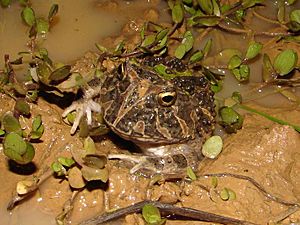Venezuelan horned frog facts for kids
Quick facts for kids Venezuelan horned frog |
|
|---|---|
 |
|
| Conservation status | |
| Scientific classification |
The Colombian horned frog or Venezuelan horned frog (Ceratophrys calcarata) is a special type of frog. It belongs to the Ceratophryidae family, which is known for its unique frogs.
This frog lives in two South American countries: Colombia and Venezuela. You can find it in dry areas like savannas, which are grasslands with scattered trees. It also lives in dry shrublands, open grasslands, and even in marshes that sometimes dry up.
Contents
Meet the Venezuelan Horned Frog
The Venezuelan horned frog is a fascinating amphibian. It is known for its wide mouth and the horn-like bumps above its eyes. These "horns" are not real horns but pointed skin folds.
What Does It Look Like?
This frog has a round, stout body. Its skin can be many colors, like green, brown, or even yellow. This helps it blend in with its surroundings. It has a very large mouth, which is perfect for catching its food.
Where Does It Live?
The Venezuelan horned frog prefers dry places. It lives in areas with tall grasses and shrubs. These habitats provide good hiding spots for the frog. It also needs access to water, even if it's just a temporary marsh.
Its Natural Habitat
- Dry Savanna: Open grasslands with scattered trees.
- Dry Shrubland: Areas with many bushes and shrubs.
- Dry Lowland Grassland: Flat areas covered mostly in grass.
- Intermittent Freshwater Marshes: Wet areas that can dry up at certain times of the year.
What Do Horned Frogs Eat?
Venezuelan horned frogs are predators. They are known for being very still and waiting for their prey. When an unsuspecting animal comes close, they quickly jump out and grab it.
Their Diet
These frogs eat a variety of small animals. Their diet often includes insects, spiders, and even other smaller frogs. They can also eat small lizards or rodents if they get the chance. Their large mouth helps them swallow big meals.
Life Cycle and Reproduction
Like all frogs, the Venezuelan horned frog starts its life in water. They go through a process called metamorphosis. This means they change from a tadpole into an adult frog.
How They Reproduce
Female frogs lay their eggs in water. The eggs hatch into tadpoles. These tadpoles live in the water and eat tiny plants or other small things. As they grow, they develop legs and lose their tails. Eventually, they become small frogs and move onto land.
Conservation Status
The Venezuelan horned frog is currently listed as "Least Concern" by the IUCN. This means it is not in immediate danger of extinction. However, it's always important to protect their habitats.
Why Protecting Them Matters
Even if a species is not endangered, its habitat can be threatened. Changes to their environment, like deforestation or pollution, can harm frog populations. Protecting their homes helps ensure these unique frogs continue to thrive.
See also
 In Spanish: Ceratophrys calcarata para niños
In Spanish: Ceratophrys calcarata para niños


